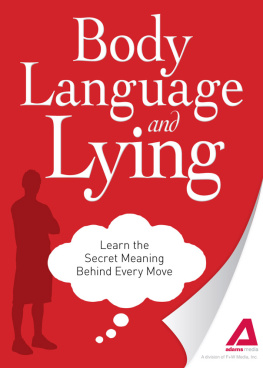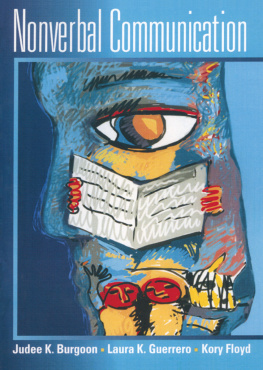Body Language
Communication Skills, Non Verbal Communication, Lying and Human Behavior
2nd Edition
Jeffery Dawson
Table of Contents
Introduction
Chapter 1: Introduction To Body Language
Chapter 2: Why Is Non Verbal Communication So Important?
Chapter 3: Types of Body Language
Chapter 4: Improve Social Skills And Enhance Leadership Qualities
Chapter 5: Improving Leadership Qualities
Chapter 6: Microexpressions: Are They Lying?
Chapter 7: Eleven Common Indicators Of A Liar
Chapter 8: Ten Tips To Keep In Mind For Stronger Body Language
Chapter 9: Ten Tips On How To Use Non Verbal Communication To Your Advantage
Bonus Chapter: Sign Language
Conclusion
Copyright 2014 by Jeffery Dawson - All rights reserved.
In no way is it legal to reproduce, duplicate, or transmit any part of this document in either electronic means or in printed format. Recording of this publication is strictly prohibited and any storage of this document is not allowed unless with written permission from the publisher. All rights reserved.
The information provided herein is stated to be truthful and consistent, in that any liability, in terms of inattention or otherwise, by any usage or abuse of any policies, processes, or directions contained within is the solitary and utter responsibility of the recipient reader. Under no circumstances will any legal responsibility or blame be held against the publisher for any reparation, damages, or monetary loss due to the information herein, either directly or indirectly.
Respective authors own all copyrights not held by the publisher.
Legal Notice:
This eBook is copyright protected. This is only for personal use. You cannot amend, distribute, sell, use, quote or paraphrase any part or the content within this eBook without the consent of the author or copyright owner. Legal action will be pursued if this is breached.
Disclaimer Notice:
Please note the information contained within this document is for educational and entertainment purposes only. Every attempt has been made to provide accurate, up to date and reliable complete information. No warranties of any kind are expressed or implied. Readers acknowledge that the author is not engaging in the rendering of legal, financial or professional advice.
By reading this document, the reader agrees that under no circumstances are we responsible for any losses, direct or indirect, which are incurred as a result of the use of information contained within this document, including, but not limited to, errors, omissions, or inaccuracies.
Introduction
Human beings are capable of feeling a sea of emotions; expressing them verbally is one of mans biggest gifts. However, not everything can be expressed with words. Certain things need a special language in order to be emoted.
That special language is known as body language.
Body language can be defined to be our bodys natural and involuntary response to a particular situation or stimulus. This reaction is a minor change from your regular behavior and without trained eyes the change may be very difficult to register or interpret.
Body language is something that is universally prevalent and all human beings make use of it sometimes to express something that they cannot express verbally. The language is in fact prevalent even in the animal kingdom where animals use body language to understand and emote their thoughts and feelings.
Everyday we come across several gestures and signals that are used in connection with speech. But since everything has multiple meanings, how many of these gestures do we really read and understand correctly? How many of these gestures effectively help us read the other persons mind? And do we interpret them the way they are meant to be? Do we end up misconstruing half of them?
Well, lets find out.
In this book, we explore the meaning of the term body language and how you can use it to your advantage. We also shed light on some of the common gestures and how you can interpret and make use of them.
Learn how to communicate clearly and more importantly, learn how to spot a liar!
Chapte r 1: Introduction To Body Language
Body language refers to the involuntary or voluntary expression of an emotion or thought, through physical behavior. Many times, we do not speak a word and yet end up conveying a message through our body language. It is essentially a culmination of several involuntary and voluntary body gestures that allow us to understand each other just by mere observation and without having to speak and listen.
We usually involuntarily convey our emotions and feelings through our body language as a reflex. For example, if you smell something rotten your first reaction is to crinkle your nose in disgust. Most of the times you do not even think about crinkling your nose and end up doing it even before you give it a second thought. Sometimes, you may voluntarily make a face or stick out your tongue to show your displeasure over the dirty smell.
See how effectively you communicated your annoyance about the smell without saying a word? This is how effective body language is. In this case, interpreting the body language was very easy and it was extremely simple to draw the conclusion as the situation and the corresponding response was pretty obvious.
A lot of times though, interpreting body language is not this easy. The art of body language has been studied for several years and many connotations have been arrived at. Despite studying body language for a while now, it can be concluded that body language is not an exact science. Various people have a different reaction in the same situation and the interpretation of the body language varies from person to person.
Bodily gestures are just as important as the activity of speaking and in fact, we emote 55% of our thoughts and feelings through body language alone. Our body language speaks volumes about us and a minor change in our behavior can set the tone of the conversation and set our image in the mind of the person we are interacting with.
Some of the various emotions that we emote through body language include excitement, anger, sadness, happiness, shame, content, relief, embarrassment and satisfaction.
One of the key aspects of reading the body language of an individual is to ensure that you know what the person is like normally, before studying their signs in a particular situation. One of the easiest ways to ensure that a person relaxed is to ask them a question that is completely unrelated to the purpose you have met for.
For example, if you are interviewing a prospective employee, he or she is bound to be nervous and this usually covers their usual behavior and makes it extremely difficult for you to get a reading off them. You can use this simple trick to ensure that the individual is relaxed. Start off by asking them a very random question, something completely unrelated to your purpose of meeting. Ask them about the people in their family or ask them about their high school or even crack a little joke about something random. This will ensure that they slowly relax and help you get a good reading off them, without the interference of their excessive stress.
Chapte r 2: Why Is Non Verbal Communication So Important?
The way you look at a person, listen to what they say and how you react to everything the other person says or does speaks a lot to the other person. By just looking at you and observing you, the other person can understand whether you are paying attention to what they have to say or show and do you even care or not.
When something you say matches with the non-verbal signs that your body is giving off, the other person is able to trust you blindly and it helps create a healthy and long lasting bond between the two of you.














